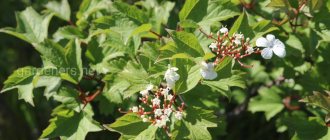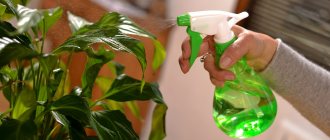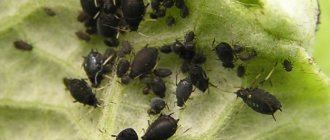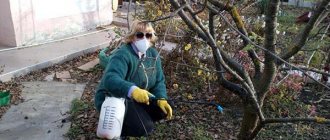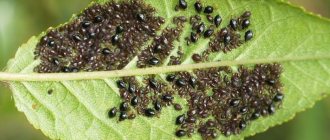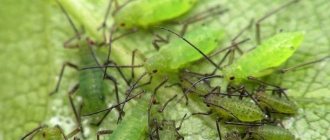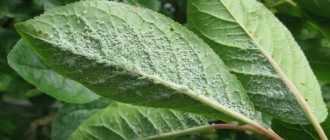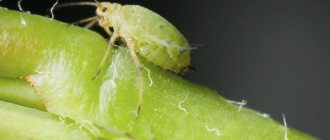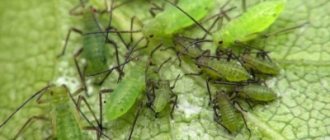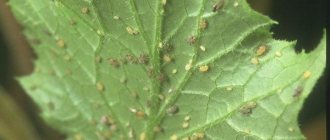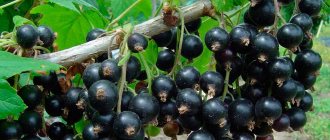Everyone knows that viburnum berries are healthy, because they contain a lot of vitamin C and other nutrients necessary for human life.
A decoction of berries helps against sore throat, bronchitis, even pneumonia.
The bark has no less useful properties, because it helps stop bleeding in case of a wound or cut, and can serve as a rinse in the treatment of periodontal disease.
Knowing which insects can cause harm to this medicinal shrub, you can take preventive measures.
About
Types of pests
Various pests can attack the viburnum bush, and each of them is characterized by its own life cycle and, accordingly, the period of time when this particular insect can be especially dangerous for the garden plot. At the same time, existing insecticides are not equally effective against various parasites.
Did you know? Science knows more than four thousand different species of aphids, about a quarter of which live in Europe. Many representatives of the aphid superfamily are monophages or oligophages (they parasitize one or more plants), but there are also omnivorous varieties of these small pests - polyphags.
Therefore, in order for the fight to preserve the future harvest or the healthy appearance of the tree (if we are talking about an ornamental variety of viburnum) to be effective, the gardener needs to clearly know which pests can eat the plant during the flowering period, and, if possible, be able to distinguish them from each other , guided by characteristic symptoms.
Aphid
Aphids are the worst enemy of a garden plot, and it is quite difficult to find a crop that this parasite would not interfere with growing and bearing fruit normally. A big fan of eating viburnum is the black viburnum aphid. The adult is a tiny flea of a dark red or dark brown color. Like all representatives of the superfamily, it feeds on sap sucked from the green organs of the plant. As a result, the affected leaves begin to curl, young shoots become deformed, and the entire bush takes on an ugly appearance.
The period of activation of the harmful effects of aphids occurs in spring and early summer, that is, it may well coincide with the flowering of viburnum.
It is in May and June that insects are visually very clearly visible on the apical shoots of the bush, so identifying the pest is not at all difficult. A characteristic sign that it was aphids that began to damage the viburnum is also the appearance on the stems and leaves of a characteristic sticky coating secreted by these insects.
By the end of summer and beginning of autumn, aphids begin to spread, seeking to occupy new territories, and after a few weeks, winged females lay eggs directly on the branches, in close proximity to the buds. Having overwintered in this way, the larvae hatching from the eggs begin the next life cycle in the spring.
Find out also how to deal with ants on viburnum.
Viburnum leaf beetle
The viburnum (or, as it is sometimes not quite correctly called, viburnum) leaf beetle in the adult state is a light brown beetle with a body length of about 5 mm. The leaf beetle begins to parasitize viburnum in the larval stage, which becomes active in early spring. It is quite difficult to notice the parasite on the bush, since the larva is attached to the underside of the leaf blade. Under favorable conditions, the pest is able to gnaw the entire leaf down to the last vein in a short time.
As a result of damage by the leaf beetle, viburnum is greatly weakened and often freezes during the winter.
The transformation of the larva into an adult occurs in the soil, where the caterpillar slides at a certain stage of its development. Having reached the surface, the adult resumes the process of eating the green part of the viburnum, but this time the beetle is already quite visible to the naked eye and parasitizes on the front side of the leaves. If the plant manages to withstand frost, in the spring it again begins to be affected by beetle larvae hatching from eggs, which the female lays deep in the wood in the fall.
Viburnum leaf roller
Traces of the vital activity of this pest are manifested in the characteristic curling of the leaves into a tube, inside which the caterpillar settles. The larvae begin this process in early spring, secreting a substance similar to a cobweb and knocking it into sticky pellets.
Like the viburnum leaf beetle, the leaf roller feeds on the pulp of leaves and is capable of eating them in huge quantities.
By mid-July, the caterpillar with a dark brown head, yellow sides and a gray or green body covered with whitish hairs turns into a pupa, after which it ceases to pose a danger to the plant for some time. However, even for insecticidal preparations, the insect tightly wrapped in a leaf plate becomes inaccessible during this period, so it is necessary to fight the leaf roller before the pupation process occurs.
We recommend that you learn how to get rid of caterpillars on viburnum.
Other pests
The three parasites mentioned above are the most likely enemies of the viburnum bush in the spring. Among other pests that a gardener may encounter while growing a plant, we can also mention:
- gall midge (viburnum and honeysuckle);
- moth (cap moth and fox moth);
- honeysuckle spiny sawfly;
- greenish lobed moth;
- comma-shaped scale insect.
However, the listed insects still appear on bushes much less frequently than aphids, leaf beetles and leaf rollers. At the same time, spider mites pose a serious danger to viburnum.
Many folk and chemical means of protecting viburnum from pests are effective against both insects and ticks, but in general, to combat arachnids, special preparations are used, which are called acaricides (“ἄκαρι”, read as “akari”, translated from ancient Greek means "mite").
Did you know? Ticks, contrary to popular belief, are not insects. They belong to the class of arthropods and are the closest relatives of spiders (the main difference between insects and arachnids is that the former have six legs, and the latter have eight).
Which side is better to plant shrubs?
Lush flowering of decorative viburnum (photo)
Decorative viburnum Buldenezh loves humidity, so it is better to plant it in areas that will provide it with this component. To do this, you can choose places near water bodies or areas below where there is no shortage of moist soil.
If the required place on the site cannot be found, then you need to keep the soil in this condition yourself. If the shrub is well-watered at the root, it can withstand the heat very easily.
Humidity is the most important point when choosing a place to plant viburnum varieties Buldenezh. In all other respects, it does not show any whimsicality; it grows well on any type of soil.
It is very important to tie up a young plant. It has delicate and fragile wood, and strong winds can break it very easily.
Buldenezh protects well from the summer heat, so it is very useful to plant it near benches or other recreation areas on the site (near the gazebo, etc.).
Viburnum diseases
In addition to insects and mites, during the flowering period, viburnum can also be affected by various diseases, primarily fungal, less often bacterial or viral. Their list includes:
- powdery mildew;
- various types of rot (some of them affect the root, others affect the above-ground part, including the leaf, stem or fruit);
- spotting;
- cytosporosis;
- tubercular necrosis of the cortex;
- drying out of branches;
- mosaic.
Fortunately, in general, viburnum has a fairly strong immunity to this kind of disease, so with proper planting and good care, you can ensure that the bush enters the flowering period healthy, and there is no need to use potent drugs to treat it.
Professional products
If the viburnum is attacked by aphids, you can fight it with professional chemical preparations based on insecticides. The active components of the product block nerve impulses, causing paralysis and early death. The minimum dose of poison is enough to cause death.
The advantages of this method of control are high efficiency, quick results, preservation of properties for up to 20 days. The insecticidal agent destroys adults and larvae of all ages.
Insecticides for insect pests
The drug is sold as a concentrate. Before use, you should prepare a solution by diluting it in a certain amount of water. Usually 10 l. While working, you must wear rubber gloves and carry out the procedure in the morning and evening in dry, windless weather.
The most effective means:
Which drug to use is an individual decision. All of them act immediately, mass death of aphids is observed within a week, and retain their properties for up to 20 days.
Before the buds open, it is recommended to treat all shoots with Nitrafen paste. You can treat viburnum against aphids during flowering using any insecticidal spray method.
How to treat a plant
All currently used means for treating viburnum from diseases and pests can be divided into two categories - chemicals and traditional methods. During flowering, it is better to give preference to the latter option as it is less dangerous for flowers and future ovaries.
Important! Traditional methods of combating garden diseases and pests are always inferior in effectiveness to modern chemical industry products, so you can use such “gentle” products either for preventive purposes or at the initial stage of a problem.
Fighting with folk remedies
Traditional methods of combating diseases and pests of garden plants differ favorably from chemical preparations in that they do not contaminate the soil, do not harm the cultivated crop and do not make its fruits dangerous for consumption. However, the above does not mean that such means can be used without any restrictions. In particular, not all methods of ridding trees and shrubs of pathogens that have affected them are acceptable during the period when the plant begins to bloom.
Video: how to protect a viburnum bush from pests
Soda-soap solution
Perhaps the most common folk method of combating aphids and other viburnum pests is a soap solution, and almost any detergent is suitable for its preparation. The idea of its use is that soap creates a thin but dense film on the surface of the leaf plate, which serves as a natural barrier for the pest or blocks its breathing. In aphids, soap, in addition, causes dehydration due to the dissolution of the protective waxy shell covering the insect's body, as a result of which the parasite dies.
To enhance the effect when preparing a soap solution, you can also add another useful ingredient to it - regular baking soda at the rate of 1 tbsp. l. with a slide for 1 liter of water. You will need about 40 g of soap for the same amount of water (if you are using a hard bar, you need to grate it first so that the soap base dissolves faster). The prepared concentrate can be stored for several weeks, diluting with water in a ratio of 1:10 before use.
Read all about the proximity of viburnum to other plants.
Ash solution
Ash, which always remains in excess at the dacha after barbecuing, also has a pronounced insecticidal and disinfecting effect. Completely burnt coals are sifted through a sieve to obtain a fine powder, which is then mixed with water (300 g per 1 liter).
The resulting suspension should be brought to a boil and simmered over low heat for about 30 minutes, then allowed to cool to room temperature. To ensure better contact with the leaf plate, it is recommended to add a little grated or liquid soap to the prepared ash solution before use.
Important! During the flowering period, it is impossible to treat viburnum with an ash solution: the ash drives away not only pests from the plant, but also insects that carry out pollination, primarily bees. As a result of such processing, you can thus be left without berries.
Tobacco solution
Tobacco is one of those plants whose smell most insects dislike. It is for this reason that our ancestors often prepared infusions or decoctions based on tobacco to protect the garden from pests. The base of such a preparation can be obtained both from tobacco leaves and from ready-made shag (even the use of crushed cigarettes or cigarettes is allowed, and the lower the quality of such a product, the better - unnecessary cleaning will only weaken the effect of the finished working solution).
Video: tobacco solution for pests
For 10 liters of water you will need about 200 g of tobacco, ground into dust. The resulting mixture should be shaken well, let sit for several hours, strain and use immediately. As an ingredient that enhances the effect of using the drug, you can add a few tablespoons of dry red pepper or a fresh chili pepper pod, cut together with seeds, to the crushed tobacco.
You might find it useful to read about planting viburnum in the spring.
When using tobacco infusion, you need to remember that tobacco, like ash, repels any insects, and not just those that are pests.
Chemicals
For chemical treatment of viburnum, systemic insecticidal (against insects) and fungicidal (against fungal diseases) preparations are used, and some of the modern products have a complex effect, that is, they help cope with both diseases and pests. A separate group of drugs is represented by the above-mentioned acaricides, which can also be produced in the form of a separate, narrowly targeted poison (for example, “Anti-mite”), or be part of more universal products (for example, colloidal sulfur is simultaneously a fungicide, acaricide and insecticide).
Among the most well-known pesticides used to treat viburnum are:
| Insecticidal preparations: | Fungicidal preparations: |
|
|
A good therapeutic and preventive effect is also achieved by spraying the bush with such proven means as:
- copper sulfate;
- Bordeaux mixture;
- carbamide (urea).
Care and watering
Ornamental viburnum Buldenezh is a very unpretentious plant; it does not require special care, but it will still require minimal care. Moreover, if you want the bush to grow faster and bloom as brightly and abundantly as possible.
Caring for such a plant includes the following points:
Mandatory watering. If the plant is not located near a body of water or in an area with well-moistened soil, then it will need (and often) be watered. Especially if summer is in full swing, which does not please with frequent rains. If the Buldenezh viburnum bush has the required amount of moisture, it will delight its owners with large flowers and a good growth rate.
Viburnum Buldenezh bush (photo)
From time to time the bush needs to be fed. You can start applying fertilizers no longer than three years after planting. It all depends on how well the hole for the plant was prepared. The fertilizers that were added there should be enough for the young bush to last two to three years.
The first fertilizing should be applied in early spring when the first leaves appear. The second - in the fall, before the leaves begin to fall.
Cleaning the plant. This procedure for the Buldenezhi bush must be carried out every year. In such cases, the branches will grow much better, and flowering will only improve. Decorative viburnum can be pruned immediately in early spring, or in late autumn, after all the leaves have fallen. You need to start cleaning after two years of plant growth.
Decorative viburnum Buldenezh will help decorate any area, giving it taste and grace. Its snow-white flower balls will only become larger and more beautiful if you properly care for this very unpretentious plant.
Preventative work
Prevention of diseases and pests is an important area in caring for any garden, vegetable or ornamental plant, because preventing a problem from occurring is much easier than dealing with its consequences. As measures that will help protect the viburnum bush from damage by certain pathogens, we can name several fundamental rules:
- At the stage of preparing the bush for winter, carefully remove from the area all plant debris that can be used by pests and fungal mycelia as a place for wintering.
- Plant plants with a strong and pungent odor near the bush that repel dangerous parasites. For example, marigolds, nasturtium, tobacco, onions, garlic, mint, rosemary, basil and many others are suitable for this purpose. etc.
- Constantly fight weeds. They are the carriers and reservoirs of most diseases that affect horticultural crops.
- Use catch belts. Many pests overwinter in the soil and in the spring they climb up the tree trunk. The main carriers of aphids are the ubiquitous ants, which feed on the sweet honeydew secreted by the pest. A mechanical barrier, placed in time at the base of the trunk, will save the bush from the spread of parasitic insects on it without the use of additional procedures and dangerous pesticides.
- Carry out regular preventive treatments of the garden with insecticidal and fungicidal preparations. The first spraying is traditionally carried out in early spring, even before the buds swell, the second - along the “green cone”. If necessary, viburnum can also be sprayed before budding and after flowering has ended.
- Carry out constant monitoring of the condition of the bush, immediately remove dried, damaged or affected branches, preventing the problem from spreading to the entire plant.
- Follow the basic agrotechnical recommendations for caring for viburnum - provide the bush with good lighting, proper watering taking into account seasonal characteristics and temperature conditions, balanced and regular feeding. These measures will strengthen the bush, increase its immunity and help the plant independently fight many problems.
Find out how to fertilize viburnum.
It is necessary to treat viburnum from diseases and pests on time, without waiting for the flowering period. In this case, the bush will not suffer from the action of a potent pesticide and at the same time will be able to remain inaccessible to dangerous insects, fungi and other pathogens. Treatment of a flowering plant can be carried out only in exceptional cases, when the potential harm that an insect or microorganism attacking it can bring to the crop clearly exceeds the risk from the action of the drug used for spraying.
Necessary prevention
Strawberry pests
To prevent viburnum diseases and to detect early signs of pests, you need to regularly inspect the plant. If the leaves begin to turn black, dry out or rot, or holes appear on them, you need to look for the cause and fight it.
For prevention and treatment, it would not be amiss to treat the bushes throughout the season with onion, garlic or tobacco infusion, as well as a soap solution (any of those described earlier). The use of insecticidal plants is ideal for the prevention of viburnum diseases, as well as for pest control. It could be horse sorrel, dandelion, wormwood.
It will not be possible to completely protect the viburnum; pests may attack again, but timely detection and destruction of harmful insects will prevent them from laying eggs.
0 0 votes
Article rating
Drugs
To combat aphids on viburnum, you can use chemicals. Today they can be contact, intestinal and systemic. Each of them has its own advantages and disadvantages
So, with the help of contact preparations, it is possible to make life easier for viburnum, because the active components of these compositions penetrate through the body and destroy aphids.
The most effective drugs remain:
- Arrivo;
Arrivo - Fury;
Fury from aphids - Fufan (how to use fufanon against weevils on strawberries is indicated here);
Fufanon for aphids - Karbafos.
But they have one drawback - those insects that could not be killed begin to actively reproduce, sensing danger.
Intestinal drugs penetrate the digestive system through the nutritional organ. Insects that fed on the drug die immediately. Among intestinal drugs, Confidor and BI-58 Novy remain effective.
The action of systemic drugs is aimed at actively penetrating the components into the tissue of the tree, making its sap poisonous. Such products should be used when treating tall trees, since spraying the crown is not so easy. Such preparations are not afraid of rain, as they are quickly absorbed by the leaves. But system tools have one drawback. You have to wait 2-3 weeks for a positive effect to be achieved.
Biological preparations can also be used to control aphids on viburnum. the most effective remain:
- Fi-toverm;
Fitoverm - Akarin;
Akarin - Agravertine CE;
- Aversectin.
When developing these drugs, we used the waste products of the soil microorganism aversectin. You can also purchase products based on cypermethrin and permethrin - Iskra, Intavir. Their peculiarity is that they quickly decompose and do not lead to the development of addiction in insects. But they have a minus - if the drugs are stored incorrectly, they will lose their properties. But you can learn how to use a spark from a weevil on strawberries from this article.
How to plant correctly?
If the planting hole has been properly prepared, then you need to plant the plant correctly. First of all, you should remove the seedling from the container and straighten the roots. You can sprinkle them with any root formation stimulator and place the plant in the prepared hole. It is important that the root collar is located several centimeters below the ground level. Then the remaining space in the hole is filled with garden soil, being sure to compact it strongly so that there are no air “pockets” left. The planted bush must be watered abundantly, and the hole must be mulched with humus, sawdust, crushed tree bark or peat chips, which will significantly reduce moisture evaporation.
Botanical characteristics
When thinking about purchasing a seedling of this beautifully flowering shrub, you should remember that you need quite a lot of space so that planting and care can be carried out without problems. Viburnum buldenezh characteristics are as follows: this plant of the Adoxaceae family is quite large, and with good care, ten years after planting, it can grow up to 3 meters in height. Its crown is large, spreading, and in adulthood its width reaches 4 meters. This shrub has light green large leaves 10-12 cm long. The most important decoration of decorative viburnum is its snow-white flowers, collected in huge inflorescences, the diameter of which can be more than 20 cm. The variety is sterile, that is, it practically does not form seeds, which determines its characteristics its reproduction. This plant is quite frost-resistant and has taken root well throughout the European territory of Russia, with the exception of the Far North and southeastern regions.
An ornamental plant such as viburnum buldenezh (planting and care must be carried out taking into account all the characteristics of the bush) can delight with its flowering for 50-60 years.
To cut or not?
Many of those who have viburnum buldenezh growing on their property ask a similar question. Planting and care, shelter for the winter - all these are mandatory and understandable procedures, but few people know why pruning is needed. In fact, in order for this decorative viburnum to form a lush and beautifully shaped crown, it needs to be pruned annually, but just be sure to remember some of the plant’s features. Formative pruning can be carried out only after the plant has flowered, shortening the side shoots, cutting out dried branches and thinning the middle of the bush. At the very end of summer, you should not prune the plant, as at this time it is preparing for the onset of cold weather. To improve flowering, young branches of buldenezh are pinched at the end of July - beginning of August. It is important to remember that this variety of viburnum buds and blooms only on last year’s shoots, and that is why you should not touch them.
Viburnum leaf beetle
It is one of the main plant pests, reaching a length of about 7 mm. Every year, one individual lays up to twenty eggs on the stems of viburnum, from which by the end of spring larvae form, which eat the leaves of the plant at a high speed.
Without killing these insects, by early summer they will turn into beetles, continuing to gnaw holes in the leaves of the tree.
Reproduction methods
Viburnum takes good cuttings, produces layering, divides the bush and propagates by seeds.
Green viburnum cuttings are harvested during the flowering period (June-early July), when they are elastic, do not break when bent, but spring back. They are cut with 2-3 nodes, 7-10 cm long. An oblique cut is made at the bottom and the leaves are removed, the cuts should be smooth. Cuttings take root well if they are treated with Kornevin or Heteroauxin. After which they are planted to a depth of 1-2 cm in a greenhouse filled with coarse river sand mixed with peat in a 1:1 ratio. The greenhouse should be covered with glass frames or plastic wrap until the cuttings take root. Rooting occurs after 3 weeks at a temperature of +27+300C and a humidity of 70%. During this period, the substrate is regularly sprayed with water. Until the end of August, while the roots are strengthening, the frames are replaced with fitting panels. For the winter, the cuttings remain in the greenhouse. They are covered with dry leaves or spruce branches, and in the spring they are planted in open ground. After 2-3 years, viburnum plants bloom.
in the article Green cuttings of woody plants.
| Cutting viburnum cuttings | Trimming viburnum cuttings |
To obtain layering, in the spring, annual shoots of viburnum are bent to the ground and radially laid out in shallow grooves, but the tip of the shoot remains on the surface. The spread out shoots are pinned with 2-3 hooks and sprinkled with loose soil or humus. For better root formation, the bark above the backfill area is tied with wire or cut. By autumn, roots develop on each horizontal layer, and young plants form from the buds, which are cut off with pruning shears and transplanted to a permanent place.
In spring or autumn, a young viburnum bush is dug up, then it is carefully divided into 2-3 parts, so that at least 2-3 renewal buds remain on each plant. This is how viburnum is propagated by dividing the bush.
| Viburnum boule de neige from cuttings | Viburnum seedlings |
For propagation by seed, large viburnum seeds are separated from the pulp before sowing. Then they are washed in water and dried in a ventilated area. Viburnum seeds can be sown in the fall. When sowing freshly harvested seeds into the ground in the fall, viburnum shoots appear only after a year. To speed up their germination, pre-sowing treatment is recommended - cold stratification. To do this, the seeds of Viburnum Viburnum and Viburnum Sargent are placed in damp sand and kept at a temperature of +4+50C for 5-6 months. For Viburnum Bureinskaya, 3-4 months of stratification is enough.
You can carry out warm-cold stratification of viburnum seeds. To do this, seeds immediately after harvesting the fruits (in September-October) are placed in boxes with damp sand and stored at a temperature of +20+28°C for 2 months, and then transferred until spring to a colder room with a temperature range from 0 to + 5°C. When sowing, the seeds are deepened into the substrate by 3-4 cm. In the spring, friendly shoots appear, and the seedlings dive into the garden bed. Viburnum seed germination lasts up to 2 years.
Viburnum gall midge
Viburnum gall midge damages plant flowers. Its larvae are white and overwinter in cobweb cocoons in the upper layers of the soil. Adult gall midges emerge when the flower buds are exposed. Females of the viburnum gall midge lay their eggs inside the bud, and the larvae also develop here. Damaged buds take on an ugly shape, become greatly enlarged, swell, turn red, their corolla thickens, and the stamens and pistil remain underdeveloped. As a result, the flowers do not open. The pest develops one generation.
Control measures. Late autumn and early spring digging of the soil. Spraying before and after flowering with 10% Karbofos, Iskra or other approved insecticides.
Viburnum gall midge
Trimming
Viburnum pruning is carried out for the purpose of sanitary cleaning, rejuvenation and crown formation. When sanitary pruning of shrubs, dry, broken and diseased shoots are systematically removed. All viburnums have a long period of shoot growth, the durability of its trunks is more than 30 years. Therefore, anti-aging pruning on viburnum is carried out no more often than after 5-7 years. Old branches are cut down to the point where stem shoots appear, leaving about 20-25 strong and large shoots. This thinning of the viburnum crown can be done in winter or early spring, in early April. It is recommended to cut bushes with weakened flowering “to the stump” at a height of 15-30 cm from the root collar. After pruning, strong young shoots develop from dormant buds, and the bush is completely restored. For abundant flowering of viburnum, it is recommended to pinch out strongly growing young shoots.
Moth
The moth family (Gracillariidae) has about 2000 species. Moths - moths often damage fruit, ornamental and industrial crops, sometimes multiplying in incredible quantities. These are small, rarely medium-sized butterflies with a wingspan of 4.5 – 21.0 mm. The head is oval or round, smooth or with a tuft of hair-like scales. The eyes are relatively large and round. The wings are narrow, lanceolate with a well-developed light, sometimes shiny pattern of clearly defined white stripes, spots or strokes on a dark background.
At the beginning of their development, caterpillars of moth moths mine the leaves of plants, then they roll up part of the leaf into a tube and skeletonize the inside of the resulting shelter. Throughout the entire period of development, the caterpillar feeds hidden in the mines inside the leaves, so pest control is difficult. The caterpillar pupates in a cocoon in a folded leaf or on its surface. The pupa overwinters in mines on fallen leaves.
Control measures. Pyrethroids, derivatives of the natural preparation pyrethrum, which have a wide spectrum of action and are odorless, are effective for pest control.
Moth - moth
Setting the stage
It is necessary to prepare the planting hole and soil in advance if you plan to plant a plant such as viburnum buldenezh. Planting and care (the photo below demonstrates) is carried out in several stages:
1. Digging a hole with a width and depth of at least 0.5 meters.
2. Water the resulting planting area abundantly with water.
3. Laying a layer of drainage, such as expanded clay, tree bark or small stones, at the bottom of the hole. This will not allow water to stagnate in the root system of the bush.
4. Filling most of the seat with a mixture, which should include:
- garden soil;
- peat;
- humus, rotted compost;
- wood ash;
- complex mineral or potassium-phosphorus fertilizer.
5. Having mixed all the ingredients, again pour plenty of water into the hole.
6. After it is absorbed, we begin planting the bush.
Fruit cap moth
The fruit cap moth is an insect of the Coleophoridae family that has narrow transparent wings with light stripes, the span of which ranges from 7 to 40 mm (Fig. 9). The fruit cap moth begins to appear from June to July. Mass reproduction is facilitated by high humidity and air temperature exceeding + 19 ... 240 C.
Moth caterpillars live in dense portable cases (hence the name of the family - Cases), which are made from mulberry or pieces of leaf epidermis; some live in stems and fruits without a case or form galls. The caterpillar overwinters, and very rarely the eggs.
The danger of the pest lies in the fact that it causes massive damage to the leaves, leading to their drying out and premature fall, thereby weakening the plant and reducing its winter hardiness.
Control measures. As measures to combat cap moth, it is recommended to spray viburnum plants twice with chemicals Kinmiks, Karbofos, Decis, etc.
Fruit cap moth
Greenish lobed moth
The greenish lobed moth (Acasis viretata) is a green and white-green caterpillar with a red-brown ringed pattern. It feeds on flowers of viburnum, lilac and other plants.
The flight of butterflies occurs in April–May and June–July. Butterflies with a wingspan of 23 - 26 mm. Juveniles are usually olive green in color, which quickly darkens. The forewings are variegated, dirty yellowish-green with light dots and transverse black lines, the middle and, partly, the outer part of the wing is black-gray, the outer edge is gray. The hind wings are light, gray tones. One generation develops per year, sometimes two (with a flight period in August and September).
Control measures. The main method of pest control is the use of insecticides against younger caterpillars during the phase of bud formation or immediately after flowering (10% Karbofos, etc.). It is advisable to treat plants only in areas of mass reproduction of pests. To determine the optimal timing of spraying, it is necessary to conduct phenological observations of the development of the pest.
Greenish lobed moth: caterpillar and butterfly
